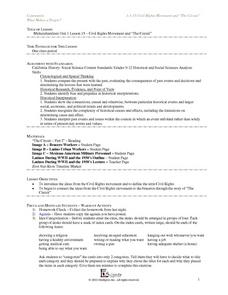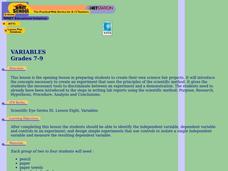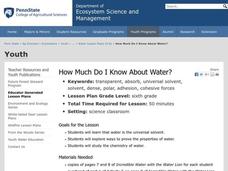Curated OER
California Primary 2000
Students explore the open primary system and the candidates that appeared on the ballot in California's Presidential Primary in 2000. A variety of issues and sites are explored and form the focus of this instructional activity.
Curated OER
Water And EcoFluxx
Learners investigate the environmental concepts covered while playing the game of Eco Fluxx. They focus upon the supply of water found in aquifers and define how they are connected to the environment. Students discuss the playing of the...
Curated OER
Ring Detectives
Students describe the overall flow of the Gulf Stream, and explain how it affects biological communities in the North Atlantic Ocean.Students describe Gulf Stream rings, and explain how they are formed.Students be abl
Curated OER
Twisted Vision
Students explain polarization vision and why some animals have it while others do not. They examine the reasons why it would be helpful for marine organisms to have polarized light.
Curated OER
Kimchee
Seventh graders examine the cultural food of the country of Korea. In groups, they discover different types of foods from different cultures with a focus on Kimchee. They identify the nutritional value of the food, how it affects the...
Curated OER
One Tough Worm
Students explain the process of chemosynthesis. They are able to explain the relevance of chemosynthesis to biological communities in the vicinity of cold seeps.
Curated OER
Art Nouveau
Students study the design elements of Art Nouveau, its sources and development. They create art projects in ceramics and glass that exemplify the focus of Art Nouveau as a decorative style.
Curated OER
Where Have All the Glaciers Gone?
Learners examine how climate change is affecting sea ice, vegetation and glaciers in the Arctic region.
Curated OER
"The Circuit" and the Civil Rights Movement
Students compare and contrast concepts of the civil rights movement to the concepts presented in the short story, "The Circuit." In groups, they sort a series of ideas written on index cards into two categories - rights and freedoms. ...
Mascil Project
Teaching Geometry Through Play
Puzzle your way through to a new understanding of area. Scholars learn about the area of polygons through equidecomposability, the idea that polygons that can be decomposed into the same set of pieces have the same area. By using...
Museum of Tolerance
Immigration Journeys
Through the journey of four stories of immigration, scholars complete graphic organizers and apply knowledge to create a visual representation of their findings on a large poster. Third and fourth readers write a letter to their family...
Curated OER
Urban Impact on Chollas Creek (California): A Field Study
Students, in groups, take samples from a creek and keep a field journal on their samples. They also perform tests on their samples.
Curated OER
Build a Journal
Students prepare for field journaling at Yosemite Institute. They create and decorate their Institute journal giving them both a place to journal and ownership of it.
Curated OER
Variables
Students watch a video show how to identify the independent variable, dependent variable and controls in an experiment; and design experiments that use controls to isolate a single independent variable and measure the resulting dependent...
Curated OER
Work Air Does
Students complete a lab observation form predicting how air makes a helicopter and pinwheel work. Constructing their own helicopter, they begin to drop it from various heights. They discuss the force on air and how it affects both objects.
Curated OER
Pollution Prevention
Learners investigate how to reduce solid and hazardous waste, and estimate the amount of household hazardous waste in their community. Students discuss methods of changing people's habits, and how to convince them to use alternative...
Curated OER
Cycling Energy
Fourth graders are introduced to how electricity is produced. In groups, they compare and contrast the linear production of energy with other forms of mechanical energy production. They try to make a turbine work acting like it is part...
Curated OER
How Much Do I Know About Water?
Sixth graders explore ways to analyze the properties of water and examine the chemistry of water. In this water instructional activity students work in groups and complete several activities.
Curated OER
How Much Do I Know About Water?
Sixth graders explore how water behaves on a penny. In this states of matter lesson, 6th graders observe water as they add drops to a penny. This lesson helps students apply the adhesive properties of water to the water cycle.
Curated OER
Weather and Climate Lesson Plan
Students distinguish between weather and climate and give examples of weather in their town, and examples of climate in their town.
Curated OER
Make a Cast of a Tyrannosaurus rex Fossil
Second graders examine the formation of fossils and list the different types. They make cast model of a dinosaur fossil. They write about conditions that are necessary for fossils to form and create a model of a buried fossil.
Curated OER
Life Through a Microscope
In this microscope usage worksheet, 7th graders complete an introduction packet that takes them through several lab activities that helps introduce and familiarize them with using the microscope.
Curated OER
Mapping Seamounts in the Gulf of Alaska
Students describe major topographic features on the Patton Seamount, and interpret two-dimensional topographic data. They create three-dimensional models of landforms from two-dimensional topographic data.
Curated OER
Magnetism: Magnet, Magnet, Where are you?
Students study the characteristics of magnets including polarity, and the concepts of attraction and repulsion. They examine how magnets are used industry.

























